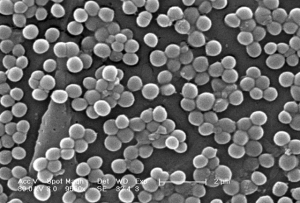by
Joan Trombetti, Writer | October 29, 2007

This scanning electron
micrograph (SEM) depicts
numerous clumps of
methicillin-resistant
Staphylococcus aureus
bacteria, commonly
referred to as MRSA.
Schools across the country are cleaning up in hopes of reassuring parents that officials are doing everything in their power to combat a bacteria, methicillin-resistant Staphylococcus aureaus (MRSA). Students are being educated about the importance of good hygiene and are being told not to share items including towels, sports equipment, or eating utensils. The infection can be spread in items used by an infected person or through skin-to-skin contact with an open wound.
MRSA does not respond to penicillin or related antibiotics, though it can be treated with other drugs. Last week, many schools were closed and events canceled in several states as cleaning crews disinfected buses, lockers and classrooms.
A growing number of cases in schools, gyms and day care centers were reported, and school officials in Mississippi, New Hampshire and Virginia reported student deaths from the bacteria. Officials in at least four other states reported cases of students being infected. In one case the skin infection was mistaken for an allergy.
A spokeswomen at the Centers for Disease Control said that the results are striking; however, it is important to realize that about 85 percent of the infections reported from the bacteria were in health care settings.
Community wise, MRSA is typically a mild skin infection that rarely becomes life-threatening and that even when it does become more severe, the death rates for this type of infection are low. The CDC did a study that showed 27 percent of all invasive MRSA infections originated in hospitals, while 58 percent started outside of a hospital environment in patients with recent exposure to a health care system. In the remaining 15 percent, cases originated in the community without any apparent health care risk factors.
